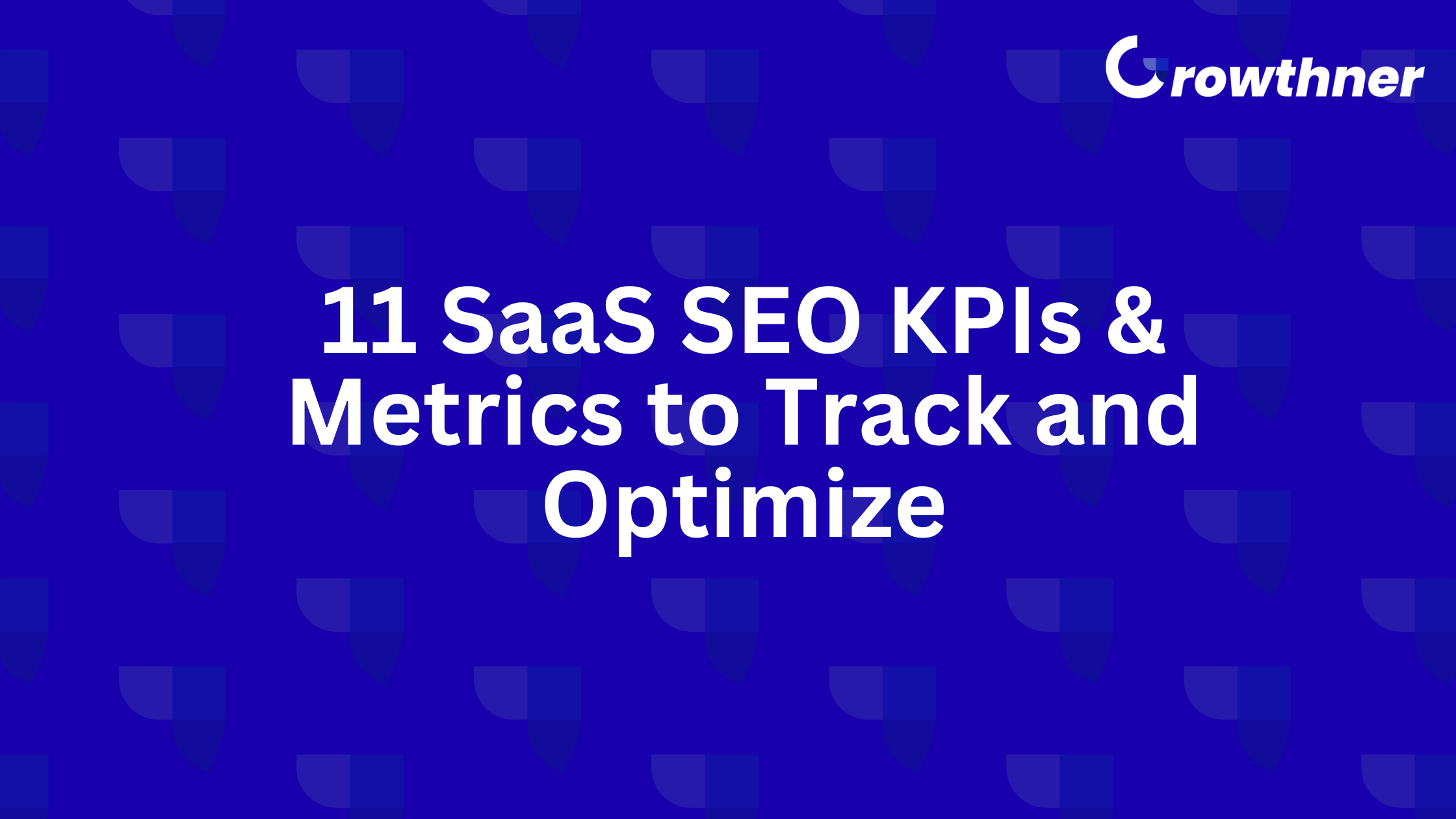11 Nov

Published by: Amit Kakkar
Published on: November 11, 2025
Last updated on: November 11, 2025
Last Updated on November 11, 2025 by admin
Your team publishes content regularly. Your rankings look decent.
But your SaaS growth remains flat.
Most SaaS companies track the wrong SEO metrics. They obsess over vanity numbers like total traffic while ignoring conversion quality.
Meanwhile, top performers focus on revenue-driven KPIs and achieve higher ROI.
This guide reveals the 11 SaaS SEO performance metrics that actually drive growth. You’ll discover which numbers predict revenue increases.
You’ll learn proven optimization techniques from companies scaling to 8-figure ARR. And you’ll get benchmarks showing exactly where you stand.
So let’s get started!
Why SaaS SEO Performance Metrics Differ from Other Industries
SaaS companies face unique measurement challenges that e-commerce and local businesses never encounter.
Your sales cycles stretch 30-90 days, not 30 minutes. Customers research extensively across multiple sessions before converting. And your revenue model depends on retention and expansion, not one-time purchases.
These differences demand different metrics. Traditional SEO KPIs like page views tell you nothing about MRR growth. You need metrics that connect organic traffic to Product Qualified Leads and customer lifetime value.
The payoff for getting this right is massive. Organic search delivers the highest ROI of any marketing channel at 49%. But only when you track metrics that align with your SaaS business model.
The 11 Essential SaaS SEO Performance Metrics
Explore 11 SaaS SEO KPIs & metrics to track and optimize in 2025:
1. Revenue from Organic Traffic
This metric reveals the actual dollars your SEO generates.
How to track it: Connect Google Analytics 4 to your CRM. Tag organic traffic as a source when leads enter your pipeline. Calculate total closed-won revenue where the first touch or last touch was organic search.
Benchmark: B2B SaaS companies average $702 customer acquisition cost through SEO. Top performers achieve 3:1 LTV to CAC ratios.
How to optimize: Focus content on high-intent keywords that buyers search near decision time. Create comparison pages targeting “[competitor] alternative” searches that convert at 8-15%. Build solution-focused content addressing specific pain points.
2. Conversion Rate from Organic Visitors
Conversion rate measures how effectively your traffic turns into leads or customers.
How to track it: Set up conversion tracking in GA4 for key actions. These include free trial signups, demo requests, and product signups. Segment by organic traffic only. Calculate: (Total Conversions ÷ Organic Sessions) × 100.
Benchmark: The median organic conversion rate for SaaS is 4.1%. Top performers hit 8-12%. SEO-driven leads convert at 14.6% compared to 1.7% for traditional methods.
How to optimize: Match landing page content to search intent precisely. Remove friction from signup flows. Add social proof and trust signals above the fold. Use “best [category] software” pages that convert at 6-12%.
3. Keyword SERP Rankings
Rankings show where you appear in search results for target keywords.
How to track it: Use SEMrush, Ahrefs, or Moz to monitor position changes. Track your top 50 priority keywords weekly. Segment into branded, product, and category keywords. Monitor featured snippet appearances separately.
Benchmark: First position gets 3.8 times more backlinks than other positions. Pages ranking first appear in featured snippets 50-65% of the time.
How to optimize: Target keywords where you rank positions 4-15 for quick wins. Update or refresh existing content to match current top-ranking pages. Add FAQ sections optimized for featured snippets. Build topical authority by covering related subtopics comprehensively.
4. Branded vs Non-Branded Traffic
This split reveals whether SEO drives new customer acquisition or just existing brand awareness.
How to track it: Create custom segments in GA4. Filter organic traffic by keywords containing your brand name versus those without. Calculate the ratio monthly. You can hire a professional SaaS link building agency to make your work easier.
Benchmark: Healthy SaaS companies see 60-70% non-branded traffic. Early-stage startups often show 80%+ branded initially.
How to optimize: Build content clusters around category keywords, not just branded terms. Target problem-aware searches like “[problem] solution” that convert at 5-10%. Create comparison content positioning against competitors. Focus link building on non-branded pages.
5. Organic Traffic Volume
Organic sessions measure how many users find you through unpaid search.
How to track it: Monitor organic traffic in GA4 under Acquisition reports. Track monthly trends rather than daily fluctuations. Segment by new vs returning visitors.
Benchmark: Google processes 16.4 billion searches daily in 2025. Organic search represents 53% of all web traffic. Top SaaS sites see 10-20% month-over-month growth in organic sessions.
How to optimize: Publish 6-8 high-quality articles monthly aligned with customer pain points. Focus on thought leadership content that generates 748% ROI. Update existing top-performing pages quarterly. Build internal links to priority pages.
6. ROI from Organic Search
ROI measures profitability by comparing revenue generated to SEO investment.
How to track it: Calculate: (Revenue from Organic – SEO Costs) ÷ SEO Costs × 100. Include content creation, tools, and contractor costs. Measure across 6-12 month periods.
Benchmark: B2B SaaS averages 702% ROI with 7-month break-even. Thought leadership SEO delivers 748% ROI. Basic content marketing only achieves 16% ROI.
| SEO Approach | ROI | Time to Break-Even |
| Thought Leadership Content (8+ posts/month) | 748% | 9 months |
| B2B SaaS Average | 702% | 7 months |
| Technical SEO Only | 117% | 6 months |
| Basic Content Marketing (4 posts/month) | 16% | 15 months |
How to optimize: Invest in high-quality strategic content over generic posts. Focus on marketing KPIs, not just traffic. Include generative engine optimization for AI search visibility. Track attribution properly across the entire customer journey.
7. Backlink Profile Growth
Backlinks signal authority and directly impact rankings.
How to track it: Use Ahrefs or SEMrush to monitor total referring domains. Track domain rating or domain authority scores monthly. Measure new backlinks gained versus lost.
Benchmark: Pages ranking first have 3.8 times more backlinks than following positions. Average page loading for top results is 1.65 seconds.
How to optimize: Create data-driven research content that attracts natural links. Build relationships with industry publications. Guest post on relevant SaaS blogs. Run digital PR campaigns around original research. Monitor competitor backlinks and replicate their link sources.
8. Bounce Rate and Engagement
Bounce rate shows how many visitors leave without interacting.
How to track it: Review bounce rate in GA4 for organic traffic specifically. Compared to engagement metrics like average session duration. Analyze by landing page to identify problems.
Benchmark: SaaS sites should target bounce rates below 50%. Pages with high engagement rank better and convert more.
How to optimize: Improve page load speed to under 2 seconds. Add internal links to related content. Create compelling above-the-fold sections. Match content precisely to search intent. Add video content that increases time on page.
9. Monthly Recurring Revenue from Organic
MRR from SEO tracks predictable revenue generated by organic channels.
How to track it: Attribute new subscriptions to organic traffic in your CRM. Calculate monthly: Sum of all recurring subscriptions where organic was the acquisition source. Track MRR growth rate month-over-month.
Benchmark: Early-stage SaaS companies should target 10-20% month-over-month MRR growth. Average monthly churn rate is 3.5%.
How to optimize: Focus content on decision-stage keywords. Create pricing comparison pages that convert at 12-20%. Reduce churn through better product activation. Optimize for customer lifetime value, not just initial conversions.
10. Organic Click-Through Rate
CTR measures how often searchers click your results versus competitors.
How to track it: Use Google Search Console to view CTR by page and query. Compare your CTR to average position benchmarks. Identify underperforming pages with good rankings but low CTR.
Benchmark: URLs containing target keywords have 45% higher CTR. Title tags with 40-60 characters perform best. Positive emotional sentiment increases CTR by 4.1%.
How to optimize: Write compelling title tags that include target keywords near the beginning. Craft meta descriptions with clear value propositions and CTAs. Add power words that trigger emotional responses. Test different titles for top-ranking pages.
11. Crawl Errors and Technical Health
Technical issues prevent search engines from indexing your content.
How to track it: Monitor Google Search Console’s Coverage report weekly. Check for 404 errors, redirect chains, and blocked resources. Run monthly crawls with Screaming Frog.
Benchmark: Only 33% of websites pass Core Web Vitals assessments. Top sites maintain zero critical errors.
How to optimize: Fix broken links immediately. Reduce redirect chains to single 301s. Ensure important pages aren’t blocked by robots.txt. Optimize Core Web Vitals scores. Monitor crawl budget allocation for large sites.
Essential Tools for Tracking SaaS SEO Performance Metrics
Utilize these below tools to track your SaaS SEO performance metrics:
- Google Analytics 4 provides conversion tracking and traffic analysis. Connect it to your CRM for revenue attribution. Set up custom events for trial signups and demos.
- Google Search Console reveals keyword performance, CTR, and technical issues. Monitor the Performance and Coverage reports weekly. Export data for deeper analysis.
- SEMrush or Ahrefs track keyword rankings, backlinks, and competitor analysis. These tools cost $99-$399 monthly but provide essential competitive insights. Both offer site audit features for technical SEO.
- Your CRM (HubSpot, Salesforce) connects organic traffic to closed revenue. Proper attribution shows which content drives high-value customers. Track customer lifetime value by acquisition source.
Start Tracking the Metrics That Matter
SaaS SEO performance metrics separate companies that scale from those that struggle.
You now know the 11 essential KPIs that predict growth. You have benchmarks showing where you stand. And you understand exactly how to track and optimize each metric.
The difference between 16% ROI and 748% ROI comes down to tracking the right numbers. Stop measuring vanity metrics. Start focusing on revenue-driven KPIs that transform SEO into your highest-performing channel.
Your competitors are already optimizing these metrics. Don’t fall behind.
Need expert help optimizing your SaaS SEO performance metrics? Contact Growthner for a comprehensive audit that reveals exactly where you’re leaving growth on the table.
FAQs
1. What are the most important SaaS SEO performance metrics to track?
Focus on revenue, conversion rate, and ROI first. These connect SEO directly to business growth. Also track organic traffic volume, keyword rankings, and MRR from organic. These five metrics predict long-term SEO success.
2. How long does it take to see ROI from SaaS SEO?
B2B SaaS companies typically break even at 7 months. Positive ROI appears within 6-12 months of consistent effort. Peak results emerge in years two and three. Track metrics monthly to identify early momentum.
3. What’s a good organic traffic conversion rate for SaaS?
The median SaaS organic conversion rate is 4.1%. Top performers achieve 8-12% through optimization. This dramatically exceeds paid social at 2.9%. Focus on high-intent keywords to improve conversion quality.
4. How do I calculate SEO ROI for my SaaS company?
Calculate: (Revenue from Organic – SEO Costs) ÷ SEO Costs × 100. Include all content, tools, and contractor expenses. Track over 6-12 month periods for accuracy. Use proper attribution connecting organic traffic to closed deals.
5. What benchmarks should I use for SaaS SEO metrics?
Target 702% ROI, 4.1%+ conversion rate, and 10-20% MoM traffic growth. Maintain 3:1 LTV to CAC ratio. Aim for 60-70% non-branded traffic. Compare against top performers, not just industry averages.







Amit Kakkar